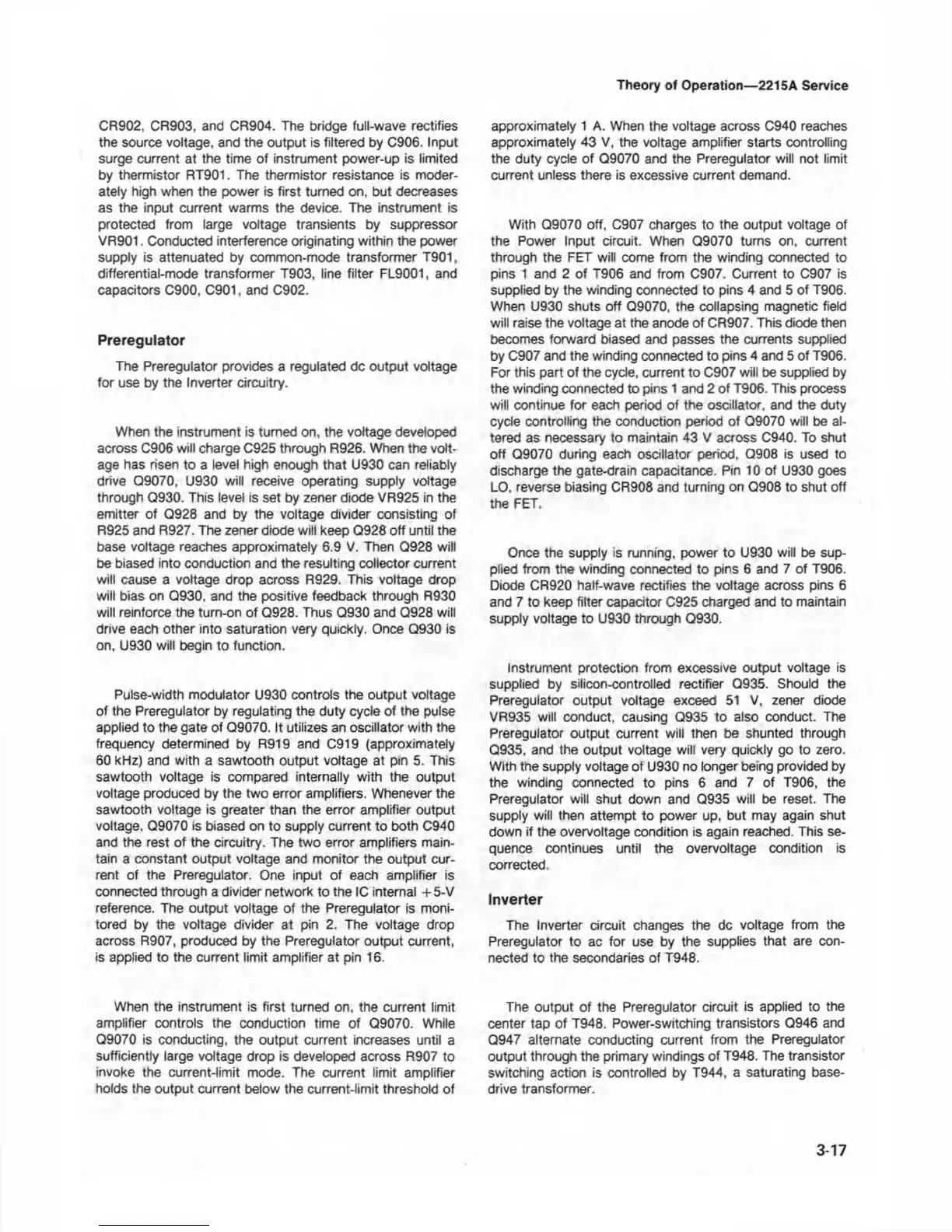Theory of Operation—2215A Service
CR902, CR903, and CR904. The bridge full-wave rectifies
the source voltage, and the output is filtered by C906. Input
surge current at the time of instrument power-up is limited
by thermistor RT901. The thermistor resistance is moder
ately high when the power is first turned on, but decreases
as the input current warms the device. The instrument is
protected from large voltage transients by suppressor
VR901. Conducted interference originating within the power
supply is attenuated by common-mode transformer T901,
differential-mode transformer T903, line filter FL9001, and
capacitors C900, C901, and C902.
Preregulator
The Preregulator provides a regulated dc output voltage
for use by the Inverter circuitry.
When the instrument is turned on, the voltage developed
across C906 will charge C925 through R926. When the volt
age has risen to a level high enough that U930 can reliably
drive Q9070, U930 will receive operating supply voltage
through Q930. This level is set by zener diode VR925 in the
emitter of Q928 and by the voltage divider consisting of
R925 and R927. The zener diode will keep Q928 off until the
base voltage reaches approximately 6.9 V. Then Q928 will
be biased into conduction and the resulting collector current
will cause a voltage drop across R929. This voltage drop
will bias on Q930, and the positive feedback through R930
will reinforce the turn-on of Q928. Thus Q930 and Q928 will
drive each other into saturation very quickly. Once Q930 is
on, U930 will begin to function.
Pulse-width modulator U930 controls the output voltage
of the Preregulator by regulating the duty cycle of the pulse
applied to the gate of Q9070. It utilizes an oscillator with the
frequency determined by R919 and C919 (approximately
60 kHz) and with a sawtooth output voltage at pin 5. This
sawtooth voltage is compared internally with the output
voltage produced by the two error amplifiers. Whenever the
sawtooth voltage is greater than the error amplifier output
voltage, Q9070 is biased on to supply current to both C940
and the rest of the circuitry. The two error amplifiers main
tain a constant output voltage and monitor the output cur
rent of the Preregulator. One input of each amplifier is
connected through a divider network to the 1C internal + 5-V
reference. The output voltage of the Preregulator is moni
tored by the voltage divider at pin 2. The voltage drop
across R907, produced by the Preregulator output current,
is applied to the current limit amplifier at pin 16.
When the instrument is first turned on, the current limit
amplifier controls the conduction time of Q9070. While
Q9070 is conducting, the output current increases until a
sufficiently large voltage drop is developed across R907 to
invoke the current-limit mode. The current limit amplifier
holds the output current below the current-limit threshold of
approximately 1 A. When the voltage across C940 reaches
approximately 43 V, the voltage amplifier starts controlling
the duty cycle of Q9070 and the Preregulator will not limit
current unless there is excessive current demand.
With Q9070 off, C907 charges to the output voltage of
the Power Input circuit. When Q9070 turns on, current
through the FET will come from the winding connected to
pins 1 and 2 of T906 and from C907. Current to C907 is
supplied by the winding connected to pins 4 and 5 of T906.
When U930 shuts off Q9070, the collapsing magnetic field
will raise the voltage at the anode of CR907. This diode then
becomes forward biased and passes the currents supplied
by C907 and the winding connected to pins 4 and 5 of T906.
For this part of the cycle, current to C907 will be supplied by
the winding connected to pins 1 and 2 of T906. This process
will continue for each period of the oscillator, and the duty
cycle controlling the conduction period of Q9070 will be al
tered as necessary to maintain 43 V across C940. To shut
off Q9070 during each oscillator period, Q908 is used to
discharge the gate-drain capacitance. Pin 10 of U930 goes
LO, reverse biasing CR908 and turning on Q908 to shut off
the FET.
Once the supply is running, power to 11930 will be sup
plied from the winding connected to pins 6 and 7 of T906.
Diode CR920 half-wave rectifies the voltage across pins 6
and 7 to keep filter capacitor C925 charged and to maintain
supply voltage to U930 through Q930.
Instrument protection from excessive output voltage is
supplied by silicon-controlled rectifier Q935. Should the
Preregulator output voltage exceed 51 V, zener diode
VR935 will conduct, causing Q935 to also conduct. The
Preregulator output current will then be shunted through
Q935, and the output voltage will very quickly go to zero.
With the supply voltage of U930 no longer being provided by
the winding connected to pins 6 and 7 of T906, the
Preregulator will shut down and Q935 will be reset. The
supply will then attempt to power up, but may again shut
down if the overvoltage condition is again reached. This se
quence continues until the overvoltage condition is
corrected.
Inverter
The Inverter circuit changes the dc voltage from the
Preregulator to ac for use by the supplies that are con
nected to the secondaries of T948.
The output of the Preregulator circuit is applied to the
center tap of T948. Power-switching transistors Q946 and
Q947 alternate conducting current from the Preregulator
output through the primary windings of T948. The transistor
switching action is controlled by T944, a saturating base-
drive transformer.
3-17

